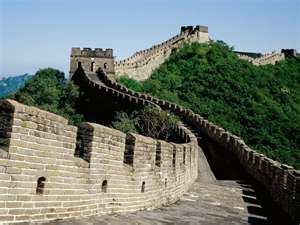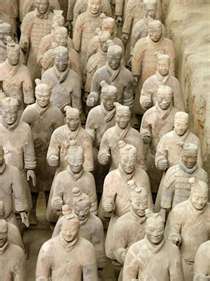China's First Emperor
Shi-huang-di was the first emperor of China. The king of the state of Qin from 246 B.C. to 221 B.C., he ended the Warring States Period by unifying the states into one empire, with himself as the head of government, ruling just 11 years before he died. During his reign as emperor, though, he had created two of the world's greatest monuments: the Great Wall and the Terracotta Army.
In 230 B.C., Zheng began a military campaign that would end in unification. The Han state (not the one that gave us the Han Dynasty) was the first to fall. The following year, in 229 B.C., a massive earthquake devastated the state of Zhao, where Zheng was born. He and his army moved in and took over. The next state to fall was Yan, in 226, followed by Wei, in 225, and Chu, in 223. Two years later, the state of Qi surrendered and Zheng was master of all China. When he defeated the last of the Warring States, Zheng declared himself emperor and took the name Shi-huang-di, which means "First sovereign emperor." The emperor took steps to maintain his authority, including reorganizing the defeated states into administrative units. In descending order of importance, these administrative units were commanderies, districts, counties, and hundred-family units. Thus, people were no longer identified with their home state. Shi-huang-di and Li Si, his chancellor, introduced a universal currency (the Ban linage coin) and universal weights and measures. They also had built a large network of roads and canals, to facilitate trade between the commanders and with the capital. Perhaps the innovation that had the most wide-ranging effect was the introduction of a universal writing language. Thus, universal trade was accompanied by universal record-keeping.
Another way that Shi-huang-di achieved consistency across his empire was to introduce a common school of thought, called Legalism. In simple terms, this system required the Chinese people to follow the laws that the emperor decreed or be punished. Up to that time, Confucianism and other philosophies had flourished in the various Chinese states, in a loose system of learning called the Hundred Schools of Thought. That encouragement of the diversity of learning did not continue under the empire. And, in order to maintain the combination of this common school of thought and a common written language, the emperor ordered the destruction of the vast majority of printed books and scrolls, since they used other languages or advocated different points of view. Exceptions to this decree of book-burning were books on agriculture, astrology, divination, medicine, and the history of the state of Qin. It wasn't only books that were burned, either. Hundreds of people who were found to have banned books were burned as well. (One exception to this was the emperor himself, who was found to have kept a collection of banned books.) As the emperor grew older, he pursued ways to stay alive forever. He visited a supposedly sacred island three times, searching for the legendary "elixir of life." He pursued other means of immortality as well, including taking mercury pills. Ironically, it was this activity that killed him, in 210 B.C. He had survived a few assassination attempts and the wars that had initially given him supreme power, but he could not survive an overdose of mercury. He died at age 49.
The Terracotta Army lasted much, much longer than the empire. When the the emperor died, he was far from home. His advisors hid the fact that he died, in order to ensure that succeeding him on the throne would be his second son, Huhai. Shi-huang-di's elder son, Fusu, duly followed the instructions to end his life (purportedly written by his father but in actuality written by the emperor's advisors) and gave way to his younger brother, Huhai, who became the Second Emperor, Qin Er Shi ("Second Generation Qin"). Sensing an opportunity, the empire's enemies fomented a number of uprisings, which resulted in the downfall of the empire. The new emperor ruled just three years before he was deposed and killed. Out of the power vacuum came the Han Dynasty.
|
|
Social Studies for Kids
copyright 2002–2025
David White



 His original name was Ying Zheng, and he was born in 259 B.C, the eldest son of the future King Zhuangxiang of Qin. When the boy was 10, his father became king. Three years later, in the middle of a war against six other states, the king died, leaving young Zheng to rule the kingdom, with a powerful family friend, Lu Buwei, as regent. When the young king was away on a military mission, the regent attempted to take over the government. The army was loyal to the king, however, and helped young Zheng put an end to the threat. The king assumed full power and appointed a man he trusted, Li Si, as chancellor (not regent).
His original name was Ying Zheng, and he was born in 259 B.C, the eldest son of the future King Zhuangxiang of Qin. When the boy was 10, his father became king. Three years later, in the middle of a war against six other states, the king died, leaving young Zheng to rule the kingdom, with a powerful family friend, Lu Buwei, as regent. When the young king was away on a military mission, the regent attempted to take over the government. The army was loyal to the king, however, and helped young Zheng put an end to the threat. The king assumed full power and appointed a man he trusted, Li Si, as chancellor (not regent). The most noticeable of the emperor's achievements, though, were too big to miss. In an attempt to keep out invaders, the emperor ordered hundreds of thousands of workers to construct a giant wall across China's northern border. This was the beginning of what is now called the
The most noticeable of the emperor's achievements, though, were too big to miss. In an attempt to keep out invaders, the emperor ordered hundreds of thousands of workers to construct a giant wall across China's northern border. This was the beginning of what is now called the  Even though Shi-huang-di toward the end of his life had sought immortality, he had an insurance policy. Early in his reign as emperor, he had ordered a massive number of workers to create another building project, a giant mausoleum, where his body would be laid after death. Buried along with him were more than 7,000 terracotta warriors, guarding the emperor against future attack. These figures, armed and standing in battle formation, were accompanied in their vigil by hundreds of terracotta horses, battle chariots, and even underground palaces and towers. The famed
Even though Shi-huang-di toward the end of his life had sought immortality, he had an insurance policy. Early in his reign as emperor, he had ordered a massive number of workers to create another building project, a giant mausoleum, where his body would be laid after death. Buried along with him were more than 7,000 terracotta warriors, guarding the emperor against future attack. These figures, armed and standing in battle formation, were accompanied in their vigil by hundreds of terracotta horses, battle chariots, and even underground palaces and towers. The famed 
